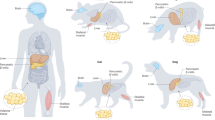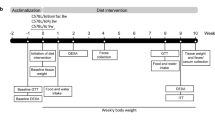Abstract
Researchers have extensively used animal models to study diabetes mellitus. In this study, the authors determined the susceptibility of three strains of Chinese minipigs to diet-induced type 2 diabetes mellitus. For 8 months, the researchers fed Nongda control minipigs (n = 4) a normal diet and fed Bama, Wuzhishan and Nongda minipigs (n = 6 per group) a high-sucrose, high-fat diet. They measured the minipigs' body weights, fasting serum glucose concentrations and insulin concentrations each month. Every 2 months, they measured serum triglyceride, cholesterol, high-density lipoprotein cholesterol (HDL-C) and low-density lipoprotein cholesterol (LDL-C) levels and carried out intravenous glucose tolerance tests (IVGTTs). The Bama and Wuzhishan minipigs were relatively susceptible to diabetes induced by the high-sucrose, high-fat diet, though susceptibility differed among individual animals in the same strain. On the other hand, Nongda minipigs were relatively resistant to diet-induced diabetes. These results provide a foundation for diabetes-related genetic analyses in minipigs with high and low susceptibility to diet-induced type 2 diabetes.
This is a preview of subscription content, access via your institution
Access options
Subscribe to this journal
We are sorry, but there is no personal subscription option available for your country.
Buy this article
- Purchase on Springer Link
- Instant access to full article PDF
Prices may be subject to local taxes which are calculated during checkout


Similar content being viewed by others
References
Sale, M.M. & Rich, S.S. Genetic contributions to type 2 diabetes: recent insights. Expert Rev. Mol. Diagn. 7, 207–217 (2007).
Rees, D.A. & Alcolado, J.C. Animal models of diabetes mellitus. Diabet. Med. 22, 359–375 (2005).
Swindle, M.M. ed. Swine in the Laboratory: Surgery, Anesthesia, Imaging, and Experimental Techniques 2nd edn. (CRC, Boca Raton, FL, 2007).
Zhang, D.F. & Liu, D. International research for minipig as experimental animal. Bull. Biol. 39, 14–16 (2004).
Pei, D.Z. Brief description of the experimental animal science and management for Chinese experimental minipig. Laboratory Animal Science and Administration 14, 36–37 (1997).
Mather, K.J. et al. Repeatability characteristics of simple indices of insulin resistance: implications for research applications. J. Clin. Endocrinol. Metab. 86, 5457–5464 (2001).
Matthews, D.R. et al. Homeostasis model assessment: insulin resistance and β-cell function from fasting plasma glucose and insulin concentrations in man. Diabetologia 28, 412–419 (1985).
Katz, A. et al. Quantitative insulin sensitivity check index: a simple, accurate method for assessing insulin sensitivity in humans. J. Clin. Endocrinol. Metab. 85, 2402–2410 (2000).
Kadowaki, T. Insights into insulin resistance and type 2 diabetes from knockout mouse models. J. Clin. Invest. 106, 459–465 (2000).
Schatz, D., Gale, E.A. & Atkinson, M.A. Why can't we prevent type 1 diabetes? Maybe it's time to try a different combination. Diabetes Care 26, 3326–3328 (2003).
Bellinger, D.A., Merricks, E.P. & Nichols, T.C. Swine models of type 2 diabetes mellitus: insulin resistance, glucose tolerance, and cardiovascular complications. ILAR J 47, 243–258 (2006).
Larsen, M.O. & Rolin, B. Use of the Göttingen minipig as a model of diabetes, with special focus on type 1 diabetes research. ILAR J 45, 303–313 (2004).
Johansen, T., Hansen, H.S., Richelsen, B. & Malmlöf, R. The obese Göttingen minipig as a model of the metabolic syndrome: dietary effects on obesity, insulin sensitivity, and growth hormone profile. Comp. Med. 51, 150–155 (2001).
Larsen, M.O., Rolin, B., Wilken, M., Carr, R.D. & Svendsen, O. High-fat high-energy feeding impairs fasting glucose and increases fasting insulin levels in the Göttingen minipig: results from a pilot study. Ann. N. Y. Acad. Sci. 967, 414–423 (2006).
Kaufman, F.R. Type 2 diabetes in children and youth. Endocrinol. Metab. Clin. North Am. 34, 659–676 ix–x (2005).
Winzell, M.S. & Ahrén, B. The high-fat diet-fed mouse: a model for studying mechanisms and treatment of impaired glucose tolerance and type 2 diabetes. Diabetes 53, S215–S219 (2004).
Huang, B.W., Chiang, M.T., Yao, H.T. & Chiang, W. The effect of high-fat and high-fructose diets on glucose tolerance and plasma lipid and leptin levels in rats. Diabetes Obes. Metab. 6, 120–126 (2004).
Yao, F. et al. The establishment of animal model of Guizhou minipig with type 2 diabetes mellitus. J. Nanhua University (Medical Edition) 32, 294–297 (2004).
Xi, S. et al. A minipig model of high-fat/high-sucrose diet-induced diabetes and atherosclerosis. Int. J. Exp. Path. 85, 223–231 (2004).
Dyson, M.C., Alloosh, M., Vuchetich, J.P., Mokelke, E.A. & Sturek, M. Components of metabolic syndrome and coronary artery disease in female Ossabaw swine fed excess atherogenic diet. Comp. Med. 56, 35–45 (2006).
Bratz, I.N. et al. Impaired capsaicin-induced relaxation of coronary arteries in a porcine model of the metabolic syndrome. Am. J. Physiol. Heart Circ. Physiol. 294, H2489–H2496 (2008).
Sturek, M. et al. Ossabaw Island miniature swine: cardiometabolic syndrome assessment. in Swine in the Laboratory: Surgery, Anesthesia, Imaging, and Experimental Techniques 2nd edn. (ed. Swindle, M.M.) 397–429 (CRC, Boca Raton, FL, 2007).
American Diabetes Association. Diagnosis and classification of diabetes mellitus. Diabetes Care 28, S37–S42 (2005).
Ellegaard, L., Jørgensen, K.D., Klastrup, S., Hansen, A.K. & Svendson, O. Haematologic and clinical chemical values in 3 and 6 month old Göttingen minipigs. Scand. J. Lab. Anim. Sci. 22, 239–248 (1995).
Wang, A.D. The select breeding of the Guangxi Bama minipig. J. Chinese Comp. Med. 14, 160–162 (2004).
Feng, S.T. & Chen, Y.C. Studies on the biological characteristics, ex situ breeding and genetic diversity of Wuzhishan Pig. Chinese Biodiversity 6, 172–179 (1998).
Zheng, Y. The result of “development of experimental inbred WUZHISHAN pig and basic research of molecular genetics” passed identification. Chinese J. Anim. Vet. Sci. 5, 421 (2005).
Yu, S.M., Wang, C.W., Zhao, D.M., Zhang, Q.C. & Pei, D.Z. The breeding of Chinese experiment minipig and its decontaminate. Laboratory Animal Science and Administration 20, 44–46 (2003).
Gan, S.X., Qian, N., Feng, J.F. & Dong, F.L. Introduction. in Atlas of Histology for Guizhou Minipig. (Guizhou Science and Technology Press, Guiyang, China, 2001).
Phillips, R.W., Westmoreland, N., Panepinto, L. & Case, G.L. Dietary effects on metabolism of Yucatan miniature swine selected for low and high glucose utilization. J. Nutr. 112, 104–111 (1981).
Phillips, R.W., Panepinto, L.M. & Will, D.H. Genetic selection for diabetogenic traits in Yucatan miniature swine. Diabetes 28, 1102–1107 (1979).
Hand, M.S., Surwit, R.S., Rodin, J., Van Order, P. & Feinglos, M.N. Failure of genetically selected miniature swine to model NIDDM. Diabetes 36, 284–287 (1987).
Boullion, R.D. et al. Porcine model of diabetic dyslipidemia: insulin and feed algorithms for mimicking diabetes in humans. Comp. Med. 53, 42–52 (2003).
Otis, C.R., Wamhoff, B.R. & Sturek, M. Hyperglycemia-induced insulin resistance in diabetic dyslipidemic Yucatan swine. Comp. Med. 53, 53–64 (2003).
Gerrity, R.G., Natarajan, R., Nadler, J.L. & Kimsey, T. Diabetes-induced accelerated atherosclerosis in swine. Diabetes 50, 1654–1665 (2001).
Zhu, H.X., Su, B.Y. & Ying, D.J. Introduction. in Anatomic Histology of Banna Minipig Inbred-lines 1–5 (Higher Education, Beijing, 2004).
Author information
Authors and Affiliations
Corresponding author
Ethics declarations
Competing interests
The authors declare no competing financial interests.
Rights and permissions
About this article
Cite this article
Chen, H., Liu, Yq., Li, Ch. et al. The susceptibility of three strains of Chinese minipigs to diet-induced type 2 diabetes mellitus. Lab Anim 38, 355–363 (2009). https://doi.org/10.1038/laban1109-355
Received:
Accepted:
Issue Date:
DOI: https://doi.org/10.1038/laban1109-355
This article is cited by
-
Porcine models for studying complications and organ crosstalk in diabetes mellitus
Cell and Tissue Research (2020)
-
Hyperinsulinemia shifted energy supply from glucose to ketone bodies in early nonalcoholic steatohepatitis from high-fat high-sucrose diet induced Bama minipigs
Scientific Reports (2015)



